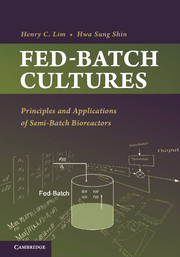Book contents
- Frontmatter
- Contents
- Preface
- Acknowledgments
- 1 Introduction to Fed-Batch Cultures
- 2 Idealized Reactors and Fed-Batch Reactors
- 3 Maximization of Reaction Rates and Fed-Batch Operation
- 4 Phenomena That Favor Fed-Batch Operations
- 5 Classification and Characteristics of Fed-Batch Cultures
- 6 Models Based on Mass Balance Equations
- 7 Non–Equation-Based Models
- 8 Specific Rate Determination
- 9 Optimization by Pontryagin's Maximum Principle
- 10 Computational Techniques
- 11 Optimization of Single and Multiple Reactions
- 12 Optimization for Cell Mass Production
- 13 Optimization for Metabolite Production
- 14 Simple Adaptive Optimization
- 15 Measurements, Estimation, and Control
- 16 Feasibility Assessment and Implementable Feed Rates
- Index
- References
7 - Non–Equation-Based Models
Published online by Cambridge University Press: 05 April 2013
- Frontmatter
- Contents
- Preface
- Acknowledgments
- 1 Introduction to Fed-Batch Cultures
- 2 Idealized Reactors and Fed-Batch Reactors
- 3 Maximization of Reaction Rates and Fed-Batch Operation
- 4 Phenomena That Favor Fed-Batch Operations
- 5 Classification and Characteristics of Fed-Batch Cultures
- 6 Models Based on Mass Balance Equations
- 7 Non–Equation-Based Models
- 8 Specific Rate Determination
- 9 Optimization by Pontryagin's Maximum Principle
- 10 Computational Techniques
- 11 Optimization of Single and Multiple Reactions
- 12 Optimization for Cell Mass Production
- 13 Optimization for Metabolite Production
- 14 Simple Adaptive Optimization
- 15 Measurements, Estimation, and Control
- 16 Feasibility Assessment and Implementable Feed Rates
- Index
- References
Summary
When it is possible to write a complete set of mass and energy balance equations with kinetics and perhaps mass transfer rates, that is, specific rates of cell growth, product formation, formation of intermediates, and substrate consumption and mass transfer coefficients, it is possible to develop a model with a number of process parameters. Then, appropriate experimental data are generated and used to estimate the parameters in the model. However, there are many situations in which it is not possible to write a complete set of mass and energy balance equations due to lack of knowledge and understanding, for example, tissue cultures that are too complex and a lack of knowledge to be able to provide an adequate description with a limited number of balance equations. Effects of medium components on the outcome of fermentation are not well known theoretically, and therefore, empirical approaches have been used. A number of approaches can be adapted for dynamic as well as static relationships. We shall consider these approaches.
In certain situations, it is not possible to measure all state variables that describe the process. Some of the state variables cannot be readily measured or are difficult to measure in the time span necessary. Therefore, we need a method of estimating not only the parameters but also some of the difficult-to-measure state variables.
- Type
- Chapter
- Information
- Fed-Batch CulturesPrinciples and Applications of Semi-Batch Bioreactors, pp. 121 - 134Publisher: Cambridge University PressPrint publication year: 2013



